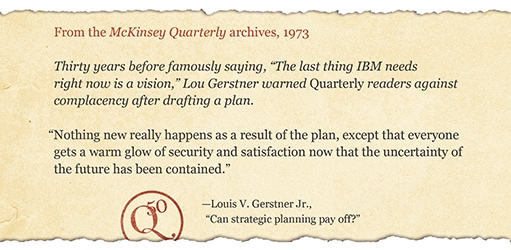Lou Gerstner will always be known as the man who saved IBM after resuscitating, then reinvigorating, the near bankrupt company when he took over as chairman and CEO in 1993. Gerstner’s career, though, spanned 43 years which also included more than a decade at McKinsey, senior positions at American Express, and four years as chairman and CEO of RJR Nabisco. Since stepping down from IBM in 2002 he has continued to lead an active “portfolio” life in education, healthcare, and private equity. In this conversation with former McKinsey managing director Ian Davis, he reflects on the DNA of companies that keep on creating value.
The Quarterly: How do you think about corporate longevity? Does it help executives if their companies explicitly aim to be around a long time, by which I mean a generation or more?
Lou Gerstner: I don’t think so. It seems to me that companies should focus on trying to be successful five years from now, perhaps ten. If your business has already been around, say, 20 years, I don’t see how it can help the management team if one of the primary objectives is getting to 100. It’s not something they can execute on. I’m not sure what you can do to guarantee success in that time frame, or even on a 20- to 30-year view.
The Quarterly: So why do some businesses last much longer than others?
Lou Gerstner: A lot of it has to do with the industry. Many companies that have made it over many years have been in slow-changing industries that haven’t been much affected by the external environment, that are characterized by significant scale economies, or that are heavily regulated.
Take food production. The big global players in this sector are not, typically, huge profit generators, and their turnover only increases modestly—say, by 1 to 2 percent a year, in line with demographic trends. But those businesses are in a nice place: there’s not much new competition, and the changes they’re up against, whether technological or otherwise, tend to be relatively small. In the automobile industry, it’s long cycle times and scale economies that deter others. And in banking, it’s been regulation. You see a lot of small bank start-ups in the US but the reason that so many of the large players have been around a long time is that state and federal laws make it difficult to start a national bank.
The Quarterly: Conversely, the entry and exit barriers are much lower in, say, software or technology, where capital requirements for new entrants can be relatively light.
Lou Gerstner: That’s true, and it’s in those sectors that companies are most often subject to strong competition, technological innovation, and regulatory change. The question, at the end of the day, is whether leaders in these and other industries can adjust. I would argue that more often than not they can’t. Think about all those companies in the computer or consumer-electronics industries, like Control Data or RCA. Corporate longevity is either driven by the leadership team that is there or by a new one that comes in from the outside and is able to manage the transition to a significantly different competitive environment. There was nothing that said American Express or IBM couldn’t go out of business, and IBM very nearly did. For a long time, American Express wouldn’t go into credit cards, because it thought that would cannibalize its Travelers Cheques business. When I arrived at IBM in 1993, there was no inheritable or even extendable platform. The company was dying.
The Quarterly: Is there something in the DNA of those firms that have endured—perhaps a willingness to respond to a change of direction—that enables them to survive?
Lou Gerstner: In anything other than a protected industry, longevity is the capacity to change, not to stay with what you’ve got. Too many companies build up an internal commitment to their existing businesses, and there’s the problem: it’s very, very difficult to “eat your seed corn,” go into other activities, or radically change something fundamental about what you’ve been doing, like the pricing structure or distribution system. Rather than changing, they find it easier to just keep doing the same things that brought them success. They codify why they’re successful. They write guidebooks. They create teaching manuals. They create whole cultures around sustaining the model. That’s great until the model gets threatened by external change; then, all too often, the adjustment is discontinuous. It requires a wrench, often from an outside force. Andy Grove put it well when he said “only the paranoid survive.”
Remember that the enduring companies we see are not really companies that have lasted for 100 years. They’ve changed 25 times or 5 times or 4 times over that 100 years, and they aren’t the same companies as they were. If they hadn’t changed, they wouldn’t have survived. If you could take a snapshot of the values and processes of most companies 50 years ago—and did the same with a surviving company in 2014—you would say it’s a different company other than, perhaps, its name and maybe its purpose and maybe its industry. The leadership that really counts is the leadership that keeps a company changing in an incremental, continuous fashion. It’s constantly focusing on the outside, on what’s going on in the marketplace, what’s changing there, noticing what competitors are doing.

The Quarterly: How important are values in sustaining companies, even those that change? And can values be an enemy of change?
Lou Gerstner: I think values are really, really important, but I also think that too many values are just words. When I teach at the IBM School, I use the annual reports of about ten major companies that invariably announce, on the back page or inside back page, “These are our values.” What’s striking to me is that almost all the values are the same. “We focus on our customers; we value teamwork; we respect the dignity of our workforce.”
But when you go inside those companies, you often see that the words don’t translate into practices. When I arrived at IBM, one of my first questions was, “Do we have teamwork?,” because the new strategy crucially depended on our ability to provide an integrated approach to our customers. “Oh, yes, Lou, we have teamwork,” I was told. “Look at those banners up there. Mr. Watson put them up in 1938; they’re still there. Teamwork!” “Oh, good,” I responded. “How do we pay people?” “Oh, we pay on individual performance.” The rewards system is a powerful driver of behavior and therefore culture. Teamwork is hard to cultivate in a world where employees are paid solely on their individual performance.
I found a similar problem at American Express, where our stated distinguishing capability was the quality of the service we delivered versus that of our competitors Visa and MasterCard, which were owned by a diverse group of bank holding companies. It turned out that on a quarterly basis, we only measured financial performance and that the assessment of our service quality, on crucial customer-satisfaction matters such as statement clarity or phone-call wait times, was only done once a year. People do what you inspect—not what you expect.
If the practices and processes inside a company don’t drive the execution of values, then people don’t get it. The question is, do you create a culture of behavior and action that really demonstrates those values and a reward system for those who adhere to them? At American Express, we had an annual award for people, all over the world, who delivered great service. One winner I’ll never forget was a young chauffeur whose car windscreen had smashed and hit him in the head while he was driving an American Express client to the airport. Bleeding profusely, he continued the journey and got the client to the plane on time. By explicitly recognizing through worldwide communications the incredible commitment of people like this (and the rewards they receive), you can get people to behave in a certain way. Simply talking about it as part of your values isn’t enough.
The Quarterly: Some companies with reputedly strong values still find it hard to change. Do values ever get in the way of the adjustment you are talking about?
Lou Gerstner: I find it hard to think about bad values per se. The problem, as I say, comes when values are simply ignored and not reinforced every day by the internal processes of the company. The fault lies in not demanding adherence to the important values: sensitivity to the marketplace, awareness of competitors, and a willingness to deliver to the customer whatever he or she wants, regardless of what your internal historical assets have been.
In that sort of situation, it’s very hard to change. IBM was enamored with mainframes because mainframes made all the money. But if we were going to change, we had to find a way to take the money away from mainframes and allocate it to something else. So it isn’t what companies say; it’s what they do. Do you think Eastman Kodak didn’t see the move from analog to digital photography? Of course they did. They invented it. But if they had a value—I’m sure they did—of being market sensitive and following the customer, they didn’t follow it. They didn’t make the shift.
The Quarterly: Are there any relevant lessons from your post-IBM experience in the private-equity industry?
Lou Gerstner: I think that private-equity activity tends to come at the end of the corporate cycle, when a company is already in trouble, has been mismanaged, or is an orphan in need of new leadership. So private equity is another outside agent that comes in when management has failed to do what it needs to do.
The Quarterly: Is the management of generational change within a company an important component of adaptability and staying sensitive to the market? Does involving younger people meaningfully in routine decisions help create the right conditions for change?
Lou Gerstner: The problem with all of these things is that there’s a ditch on both sides of the road. I’ve known times in my career when older and wiser heads restrained younger people carried away by short-term dollar signs. So it’s hard to generalize, but certainly you have to listen to all the executive team. Organizations, in my experience, tend to be healthiest where there is a supremacy of ideas, where people are willing to listen to the youngest person in the room—provided, of course, that he or she has the facts.
My successor at IBM has embraced what we called an IBM jam. It goes on for several days; every IBMer could dial in and discuss important topics like cloud computing or mobile computing. That represented a real effort at IBM to tap the ideas of the younger, newer employees, not just the senior executives. Always listening to the younger folks won’t guarantee you the best strategy. But if you don’t listen to them at all, you won’t get it either.
The Quarterly: Do you think ownership structure makes a difference? We’ve noticed that a large proportion of enduring companies have been privately owned.
Lou Gerstner: There are obviously many more private companies than public companies, certainly in the United States, so you would probably expect this outcome. One thing I would say, though, is that the preoccupation with short-term earnings in the public-company environment—not something private companies are so concerned with—is quite destructive of longevity.
And that’s a bad thing. Who says the analysts are right when they mark down a company’s stock just because it makes 89 cents in the first quarter rather than the 93 forecast by the market? Are they thinking about the long-term competitiveness of the company? Are they thinking this would have been a good time to reinvest, or are they just churning out numbers and saying they want earnings per share to go up every quarter? This kind of short-term pressure on current earnings can lead to underinvestment in the long-term competitiveness of a business.
It’s very interesting to me that a company like Amazon has been able to convince the world that it doesn’t have to make meaningful earnings, because it’s investing for the future—building warehouses and building distribution and building hardware and software applications. It’s so rare to see that happening. It’s like they’re acting like a private company. It could be that private companies can operate without the pressure of trade-offs of short- and long-term investment and performance.



